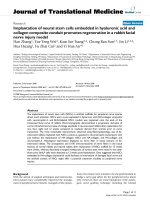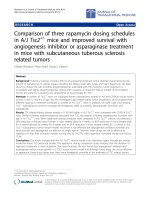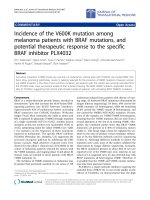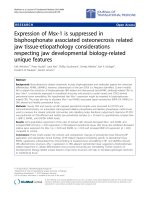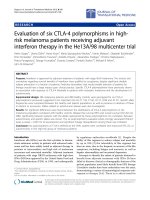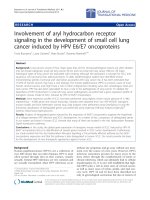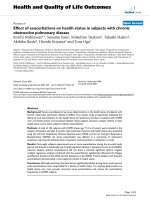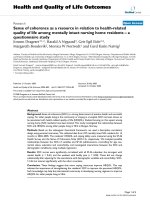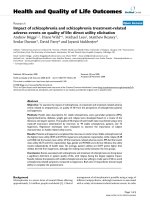báo cáo hóa học:" Study of quality of life and its determinants in patients after urinary stone fragmentation" docx
Bạn đang xem bản rút gọn của tài liệu. Xem và tải ngay bản đầy đủ của tài liệu tại đây (226.65 KB, 6 trang )
RESEARC H Open Access
Study of quality of life and its determinants in
patients after urinary stone fragmentation
Mostafa A Arafa
*
, Danny M Rabah
Abstract
Background: This study was designed to evaluate the health-related quality of life (HRQOL) of patients who had
undergone lithotripsy for treatment of urinary stones and to identify factors that significantly affect the HRQOL of
these patients.
Methods: A comparative cross-sectional study was performed at the main university and main Ministry of health
hospitals in Riyadh, Saudi Arabia. All patients admitted to the urology service and who underwent lithotripsy for
urinary stones during a 9-month period were included in the study. An observation period of 3-15 months
following the last treatment was allowed before patients completed the QOL questionnaire. Information on socio-
demographic, and medical characteristics, and number and type of lithotripsies were collected. The Medical
Outcome Study Short-Form 36-item survey (SF-36) was used to assess HRQoL. For comparison, the HRQoL in an
equal number of healthy individuals was investigated; multivariate analysis of variance was used for comparisons
between groups.
Results: Compared with healthy subjects, lithotripsy patients had significantly higher mean scores in the different
subscales of the SF-36 questionnaire such as physical functioning, vitality, role-physical, role-emotional and mental
health, indicating a better HRQOL. Compared with patients who underwent ureteroscopic or extracorporeal shock-
wave lithotripsies, those who underwent percutaneous lithotripsy had significantly worse mean scores for all the
SF-36 scales, except for body pain. Factors impacting HRQOL of the patients were age, obesity, diabetes mellitus,
and stone characteristics such as localization (in the kidney) and recurrence (multiple lithotripsies).
Conclusions: Post-lithotripsy, patients have a favorable HRQOL compared with healthy volunteers. Further
prospective studies are warranted to confirm these results owing to the inherent limitations of the cross-sectional
design and backward analysis of this study.
Background
Stone formation in the urinary tract is a common and
serious problem encountered in regular urolog ical prac-
tice. With a p revalence of more than 10% and an
expected recurrence rate of approximately 50%, stone
disease has important implications in the healthcare sys-
tem [1,2]. Extracorporeal shock-wave lithotripsy
(ESWL), ureteroscopy (flexible and semirigid) with intra-
corporeal lithotripsy (URS) and percutaneous nephro-
lithotripsy (PCNL) are well-established procedures for
fragmentation of stones using a lithotriptor. Each mod-
ality is associated with advantages and disadvantages,
and the choice of modality should be based on well-
defined factors, in cluding the type of stone, its location
and environment, and other anatomic characteristics [3].
The high prevalence of recurrent stone formation,
which in turn is associated with increased morbidity and
hospitalization, suggests that stone disease could be a
serious health problem that has a significant effect on
patients’ quality of life (QOL) [1,2,4]. There is an
increasing recognition that the selection of therapeutic
mod alities, irrespective of the type of disease , should be
based not only on response rates but also on the effects
on the psychological, functional, social and economic
life of the patients, including in patients who have
undergone lithotripsy for urinary stones [5].
QOL is an estimate of freedom from impairment, dis-
ability or handicap [6]. The concept of health-related QOL
* Correspondence:
King Saud University, King Khalid University Hospital, Princess Al Johara Al
Ibrahim for Cancer Research, Prostate Cancer Research Unit, KSA, Riyadh,
Saudi Arabia
Arafa and Rabah Health and Quality of Life Outcomes 2010, 8:119
/>© 2010 Arafa and Rabah; licensee BioMed Central Ltd. This is an Open Access article distributed under the terms of the Creative
Commons Attribution License ( nses /by/2.0), which permits unrestricted use, distribution, and
reproduction in any mediu m, provided the original work is properly cited.
(HRQOL) is multidimensional and includes psychosocial,
physical and emotional status, as well as patient autonomy,
and is applicable to a wide variety of medical conditions
[7]. To our knowledge, only a few studies have investigated
HRQOL in patients undergoing lithotripsy for urinary
stones and none has been conducted in Saudi Arabia.
Patient s with urinary stones represent an ideal group for
the investigation of HRQOL owing to specific features of
this disease, such as its high prevalence, peak incidence in
a socially active generation, severe symptoms and high
recurrence rate. Hence, we undertook this study to evalu-
ate the HRQOL in these patients using the SF-36 ques-
tionnaire and to investigate the factors that significantly
impact HRQOL in these patients.
Subjects and methods
This was a comparative cross-sectional study conducted
over a period of 9 months (January through September
2009)atthemainuniversityandmainMOHhospitals
in Riyadh, Saudi Arabia. All patients (n = 320) admitte d
to the urology service for surgical intervention fo r frag-
mentation of urinary stones during the period of study
were invited to participate in the study. The comparator
group consisted of an equal number of healthy volun-
teers selected from the general population or from the
individuals o r relatives accompanying patients at differ-
ent outpatient clinics. We included this comparison
group owing to the absence of a data base of population
‘norms’ for our community. Exclusion criteria for sub-
jects in t he comparative group included renal disease,
urinary stones or any other major disease that could
affect the QOL. The two groups were matched in terms
of sample size, age and sex. An observation period of
3-15 months following the last lithotripsy was allowed
before patients were asked to complete the QOL ques-
tionnaire. All patients were interviewed in person by
trained personnel at the time of their visits for follow-
up examinations. Baseline characteristics included socio-
demographic data, medical data and the presence of
conc omitant health conditions including type 2 diabet es
mellitus (DM), hypertension, gout or lower back pain.
Data concerning number and type of lithotripsies and
size of the stone were retrieved from patient records.
The Medical Outcome Study Short-Form 36-item survey
(SF-36) [8] was self-administered by both study groups
to assess the HRQOL. This tool includes eight scales
that assess the following general health measures: physi-
cal functioning (PF), role limitations due to physical
health problems (role-physical, RP), body pain (BP), gen-
eral health perceptions (GH), vitality (VT), social func-
tioning (SF), role limitations due to emotional problems
(role-emotional, RE), and mental health (MH). Subscale
scores are calculated accordi ng to standa rd procedures,
yielding score values of 0 to 100, where higher scores
indicate better QOL. The study was approved by the
institutional review boards of the participating hospitals.
All participants provided written informed consent.
Statistical analysis
Results were expressed as frequencies, means and standard
deviations. Data analysis was divided into two parts. Initi-
ally, SF-36 subscale scores for the participants were com-
pared across the two main study groups using multivariate
analysis of variance (MANOVA). Then, the SF-36 sub-
scales of lithotripsy patients were compared for the three
different types of lithotripsies, PCNL, ureteroscopy or
EWSL. MANOVA was also used to investigate the impact
of different socio-demographic, medical and other related
factors on the QOL of the patients. The final multivariate
model included lit hotripsy type plus all other variables
that could affect QOL. The alpha level for the MANOVA
test was set at 0.05. Significant statistics (p < 0.05) were
followedbypost-hocanalysestodeterminewhichsub-
scales were associated with between-group differences,
and which specific groups showed significantly differences.
Results
Subject demographics
Of the 320 patients invited to participate in the study,
275 patients were enrolled. Forty-five patients discontin-
ued due to non-compliance or loss to follow-up. The age
range of patients was 19-90 years, with a mean of 41.45 ±
10.80 years. Nearly two thirds (67%) were male. A major-
ity (92%) were educated to at least secondary school
level. Concomitant conditions of hypertension (15%),
DM (19%), overweight/obesity (23%), gout (2%) and
lower back pain (4%) were noted amon g the subjects.
Included patients had undergone PCNL (97, 35.3%), ure-
teroscopy (118, 42.9%) or ESWL (60, 21.8%). The obser-
vation period after the last lithotripsy before completion
of the SF-36 ranged from 3-15 months, with a mean of
9.23 ± 2.4 months. The comparator group (n = 275) con-
sisted of healthy volunteers matched with cases for age
and sex. Concomitant cond itions of hypertensio n (8.3%),
DM (3.3%), and overweight/obesity (15%) were also
noted in this group. There was no significant difference
between the two groups in terms of body mass index;
29 ± 4.3 for patients and 28.5 ± 3.2 for controls.
Health-related quality of life: SF-36 profile
HRQOL was assessed in the two study groups using the
SF-36 questionnaire. As seen in Table 1, lithotripsy
cases had significantly higher mean scores in the physi-
cal functioning, role-physical, vitality, role-emotional
and mental health subscales. The greatest differences
were observed in mental health (48.96 vs 45.65) and
role-emotional subscales (44.78 vs 41.94). There were
no significant differences observed in mean scores for
Arafa and Rabah Health and Quality of Life Outcomes 2010, 8:119
/>Page 2 of 6
general health and social functioning subscales. As
regards body pain, lithotripsy cases reported a signifi-
cantly lower mean score than controls (47.10 vs 49.80).
Table 2 shows a comparative analysis of HRQOL by
type of lithotripsy. Patients who underwent PCNL had sig-
nificantly worse mean scores for all HRQOL domains,
except for body pain, while the ESWL patients reported
the hi ghest HRQOL scores. The overall test statistic was
statistically significant (p < 0.001) for the eight subscales,
indicating that there was a correlation between type of
lithotripsy and HRQOL.
The impact of socio-demographic factors, presence of
co-morbidities and other re lated clinical variables on
HRQOL of patients is show n in Table 3. Factors such as
age, localization of the stone (in the kidney) and recurrent
stones (multiple lithotripsies) significantly affected the
HRQOL of patients. Among the concomitant conditions,
obesityandDMwerefoundtohaveasignificantimpact
on HRQOL. It should be noted that the results of the uni-
variate analysis indicated a significant association between
poor HRQOL and localization of the stone and recurrent
stones in the areas of vitality and mental health. Obesity
and DM (type 2) were associated with decreased physical
functioning, vitality, role-physical and general health
scores. Notably, advanced age significantly reduced
HRQOL score s in all domains (data not shown). The Eta
square presented in Table 3 reflects the proportion of total
variability attributable to each factor.
Discussion
The prevalence of urinary calculi is estimated to be
1-5% worldwide and it is th e third most common pro-
blem in urology clinics after urinary tract infection and
prostate diseases [9-12]. Moreover, stone disease is one
of the most costly diseases worldwide and needs good
management and prevention. Many techniques ha ve
been proposed for urinary stone management, and sev-
eral techniques have been developed. Consequently,
quantifying clinical results is of critical importance in
this non-life threatening disease [13].
Urinary stones can cause a variety of painful symptoms
that typically worsen over time, with a high recurrence
rate involving about 70% of patients within 20 years of
the first renal colic episode and 50% from 4-5 years after
the first episode [14]. If symptoms are left unchecked and
neglected, these patients are more likely to develop
related diseases that will make their health condition
more complicated and, in turn, affect their QOL.
Many stones remain asymptomatic for long periods of
time, whereas others are associated with symptoms that
may necess itate physician evaluation, emergency depart-
ment visits, hospitalization, or surgical intervention.
Table 1 Comparison of SF-36 subscales between healthy volunteers (comparator group, n = 275) and patients who
had undergone lithotripsy for removal of urinary stones (lithotripsy group, n = 275).
SF-36 Subscale Group Mean SD F Statistic P-Value
Physical Functioning
(PF)
lithotripsy group 45.43 11.30 10.37 0.001
comparator group 42.15 12.56
Role-Physical
(RP)
lithotripsy group 46.70 7.96 4.46 0.035
comparator group 45.02 10.57
Body Pain
(BP)
lithotripsy group 47.10 8.56 2.67 0.06
comparator group 49.80 9.81
General Health
(GH)
lithotripsy group 49.42 8.39 0.85 0.035
comparator group 49.28 9.33
Vitality
(VT)
lithotripsy group 55.55 10.68 4.89 0.027
comparator group 53.46 9.61
Social Functioning
(SF)
lithotripsy group 44.04 9.73 0.216 0.642
comparator group 44.01 10.86
Role-Emotional
(RE)
lithotripsy group 44.78 10.53 8.127 0.005
comparator group 41.94 12.74
Mental Health
(MH)
lithotripsy group 48.96 10.95 12.65 0.000
comparator group 45.65 10.91
Arafa and Rabah Health and Quality of Life Outcomes 2010, 8:119
/>Page 3 of 6
Although minimally invasive treatments have reduced
the morbidity associated with surgical stone manage-
ment, lifelong medication and/or dietary modification to
prevent recurrence is often necessary. In additio n, there
is an emotional burden associated wi th living with
stones caused by the uncertainty of when or if a stone
will become symptomatic [15].
Although many studies have assessed QOL in other
urologic disease, few studies have assessed QOL in litho-
tripsy patients, particularly after treatment. The current
study revealed favorable HRQOL scores in seven of the
eight SF-36 subscales for post-lithotripsy patients a few
months after their last treatment, with significantly
higher scores for PF, RP, VT, RE and MH domains
compared with the healthy control group (Table 1).
Such results may indicate the positive effect of litho-
tripsy on QOL of patients with this non-life-threatening
disease. These patient s seem to have a better apprecia-
tion of their health, both physically and emotionally,
after recovery from urinary stones than before, when
their ability to perform work or activities had been
impaired due to physical or emotional problems. The
Table 2 Comparison of SF-36 subscales between the patients who had undergone one of the three types of
lithotripsy: percutaneous (n = 97), ureteroscopic (n = 118) or extracorporeal shock wave lithotripsy (ESWL, n = 60)
SF-36 Subscale lithotripsy type Mean SD F Statistic P-Value
Physical Functioning (PF) Percutaneous 38.92 13.28 0.000
Ureteroscopy 47.84 8.02 32.82
ESWL 51.23 2.72
Role-Physical (RP) Percutaneous 43.37 8.13 0.000
Ureteroscopy 47.63 7.78 16.95
ESWL 50.24 5.83
Body Pain (BP) Percutaneous 48.06 9.74 0.002
Ureteroscopy 45.02 7.42 6.16
ESWL 49.24 5.83
General Health (GH) Percutaneous 47.50 8.46 0.007
Ureteroscopy 49.85 8.77 5.01
ESWL 51.68 6.79
Vitality (VT) Percutaneous 51.500 9.45 0.000
Ureteroscopy 55.52 10.33 19.4
ESWL 61.76 10.68
Social Functioning (SF) Percutaneous 42.45 10.30 0.000
Ureteroscopy 42.93 9.58 9.36
ESWL 48.66 7.54
Role-Emotional (RE) Percutaneous 39.64 11.31 0.000
Ureteroscoy 45.93 9.44 26.11
ESWL 50.82 6.87
Mental Health (MH) Percutaneous 44.08 10.09 0.000
Ureteroscopy 49.38 10.46 26.23
ESWL 56.01 9.16
Table 3 Manova general F test to identify factors affecting HRQoL of patients (n = 275) after lithotripsy intervention
for treatment of urinary stones.
Factor F Statistic P-Value Partial eta squared
Age 2.27 0.02 0.09
Sex 0.91 0.52 —
Site of the stone 0.57 0.79 —
Location of the stone 3.10 0.003 0.11
Presence of stent 1.64 0.31 ——
Obesity 2.57 0.01 0.12
DM (type 2) 3.12 0.001 0.13
Recurrent stone (multiple procedures) 2.26 0.02 0.23
Arafa and Rabah Health and Quality of Life Outcomes 2010, 8:119
/>Page 4 of 6
improvement in HRQOL may also be explained by the
so-called response shift [16]. According to this theoreti -
cal model, the often-seen improvement in HRQOL can
be a result of an accommodation process that involves
changing internal standards and values. It is conceivable
that the improved QOL seen in our study is due to such
a response shift. On the other hand, lithotripsy patients
reported lower BP subscale scores, which may reflect
their p ast experience with pain due to stone formation.
Kurahashi et al. [17] reported no significant differences
in scores for any scale between lithotripsy patients and
healthy volunteers, after an observation period of 3-78
months after the last treatment, in age- and gender-
matched Japanese subjects.
A marked change in the strategies for urinary stone
removal has been documented. Several types of litho-
tripsy procedures can be considered depending on clini-
cal parameters and stone characteristics. One of the
most important factors that should be considered by
clinicians when selecting the lithotripsy procedure for a
given patient is the expected c hanges in H RQOL after
the intervention. Our study shows that patients t reated
by PCNL had signi ficantly lower scores for all domains
except body pain, whereas those trea ted by ESWL had
the highest scores (Table 2). K urahashi et al. found that
patients treated by ESWL alone had a significantly
higher score for GH perception, whereas no significant
differences were detected in the remaining seven scores
[17]. On the other hand, this suggested superiority of
ESWL was not seen in the study by Mays et al. [18].
Also, according to Rayanal et al. , even a minimally inva-
sive technique for stone management is far from being
harmless to renal function and can sometimes cause
additional symptoms in patients [13].
Patient age, kidney stones, recurrent stones, obesity and
DM were the factors with a significant impact on HRQOL
in our study. This was particularly true for age, as all
domains were associated with poorer QOL, followed by
DM and obesity, where four domains were found to be
significantly affected (Table 3). Interestingly, indwelling
stents and gender did not seem to affect HRQOL scores.
Other studies have indicated that pain associated with
indwelling stents interfere with daily activities and result
in reduced QOL, yet no difference in QOL and urinary
symptoms and pain were detected using stents of different
size [19-21]. The study of Penniston and Nakada reported
that women scored significantly lower than men for all
domains [22]. The results of the current study are in
agreement with those of previous studies, namely that
quality of life impairments are magnified in patients with
associated co-morbidities such as DM, obesity, hyperten-
sion, musculoskeletal disorders, and depression [22,23].
However, in the prese nt work, only diabetes and obesity
were found to have a significant impact on QOL. Obesity
and DM type 2 are quite prevalent in Saudi Arabia, which
may explain their influence on patient H RQOL [24,25].
Another factor that had a negative impact on patient
HRQOL is recurrent stones, likely due to the effects of
recurrent symptoms due to renal colic, hence recurrent
surgical procedures that could affect patient QOL [23,26].
Potential limitations of the study
First, the follow-up period chosen in this study (3-15
months) was relatively short, because 50% of cases a re
known to recur within 5 years of the initial stone event.
Secondly, being a cross-sectional, retrospective study, we
could not evaluate the baseline HRQOL before stone
development. This may be rectified in a future study
through periodic follow-up and regular assessment o f
patient QOL. Third, stressful life events were not
ass essed in this study. It is well known that such events
can influence HRQOL and negatively impact patient
perception of health st atus. Finally, Saudi population
‘norms’ are not available, which limited the calculation
of summary composite scores.
Conclusions
Patients’ expectations and QOL are paramount in the
current era of clinical practice. Although invasive proce-
dures often have a negative effect on HRQOL, litho-
tripsy patients, after a reasonable period of recovery
from surgical procedures, had a favorable HRQOL com-
pared with a healthy control population. This is particu-
larly important for this non-life-threatening disease,
owing to the factors and surgical interventions that
could have a negative influence of patients’ QOL.
Further longitudinal and prospective studies are war-
ranted to further assess the impact of different factors
and surgical interventions on QOL and to overcome the
inherent disadvantages associated with backward studies.
Acknowledgements
This work was funded by Princess Al Johara Al Ibrahim for Cancer Research,
Prostate Cancer Research Unity, Saudi Arabia. The authors thank Dr
Anuradha Alahari of Accent Medical and Scientific Writing for copyediting
the manuscript.
Authors’ contributions
MA Participated in the design of the study, writing the paper and performed
the statistical analysis. DR Participated in its design and coordination. Both
authors read and approved the final manuscript.
Competing interests
The authors declare that they have no competing interests.
Received: 23 February 2010 Accepted: 19 October 2010
Published: 19 October 2010
References
1. Tiselius HG: Epidemiology and medical management of stone disease.
BJU Int 2003, 91(8):758-767.
Arafa and Rabah Health and Quality of Life Outcomes 2010, 8:119
/>Page 5 of 6
2. Gambaro G, Reis-Santos JM, Rao N: Nephrolithiasis: why doesn’t our
‘’learning’’ progress? Eur Urol 2004, 45(5):547-556.
3. Marchovich R, Smith AD: Renal pelvic stones: choosing shock wave
lithotripsy or percutaneous nephrolithotomy. International Braz J Urol
2003, 29(3):195-207.
4. Sandhu C, Anson KM, Patel U: Urinary tract stones–part II: current status
of treatment. Clin Radiol 2003, 58(6):422-433.
5. Fukuhara S, Koshinski M: Psychometric and clinical tests of validity of the
Japanese SF-36 health survey. J Clin Epidemiol 1998, 51(11):1045-1053.
6. Last JM, Spasoff RA, Harris SS, Thuriaux MC, Anderson JB: A dictionary of
Epidemiology. New York: Oxford University Press, 4 2001, 148.
7. Alonso J, Ferrer M, Gandek B: Health-related quality of life associated with
chronic conditions in eight countries: results from the International
Quality of Life Assessment (IQOLA) project. Qual Life Res 2004,
13(2):283-298.
8. Ware JE, Snow KK, Kosinski M, Gandek B: SF-36 health survey: manual and
interpretation guide. Boston: The Health Institute, New England Medical
Center 1993.
9. Ramello A, Vitale C, Marangella M: Epidemiology of nephrolithiasis. J
nephrol 2000, 13(Suppl 3):45-50.
10. Lee YH, Huang Tsai JY: Epidemiologic studies on the prevalence of upper
urinary tract calculi in Taiwan. Urol Int 2002, 68(3):172-177.
11. Bartoletti R, Cai T, Mondaini R, Melone F, Travaglini F, Carini M, Rizzo M:
Epidemiology and risk factors in urolithiasis. Urol Inter 2007, 79(Supp
1):3-7.
12. Ketabchi AA, Aziziolahi GA: Prevalence of symptomatic urinary calculi in
Kerman, Iran. Urology J 2008, 5(3):156-160.
13. Rayanal G, Petit J, Saint F: Which efficiency index for urinary stone
treatment? Urol Res 2009, 37(4):237-239.
14. Dinix MP, Blay SL, Schor N: Anxiety and depression symptoms in
recurrent painful renal lithiasis colic. Braz J Med Biol Res 2007, 40:949-955.
15. QoL in patients with stones: [ />patients-with-stones/article/129971/], accessed 26/1/2010.
16. Sprangers MAG, Schwartz CE: Integrating response shift into health-
related quality of life research: a theoretical model. Soc Sci Med 1999,
48(11)
:1507-1515.
17. Kurahashi T, Miyake H, Shinozaki M, Oka N, Takenaka A, Isao H, Masato F:
Health related quality of life in patients undergoing lithotripsy for
urinary stones. Int Urol nephrol 2008, 40(1):39-43.
18. Mays NB, Petruckevitch A, Snowdon C: Patients’ quality of life following
extracorporeal shock-wave lithotripsy and percutaneous
nephrolithotripsy for renal calculi. Int J Technol Assess Health care 1999,
6(4):633-42.
19. Joshi HB, Stainthorpe A, MacDonagh RP, Keeley FX Jr, Timoney AG,
Barry MJ, et al: Indwelling ureteral stents: evaluation of symptoms,
quality of life and utility. J Urol 2003, 169(3):1056-1059.
20. Leibovici D, Cooper A, Lindet A, Ostrowsky R, Kleinmann J, Velikanov S,
Cipele H, Goren E, Siegel YI: Ureteral stents: morbidity and impact on
quality of life. Isr Med assoc J 2005, 7(8):491-494.
21. Damiano R, Autorino R, De Sio M, Cantiello F, Quarto G, Perdona S, Sacco R,
D’Armiento M: Does the size of ureteral stent impact urinary symptoms
and quality of life? A prospective randomized study. Eur Urol 2005,
48(4):673-678.
22. Kristina lP, Stephen YK: Health related quality of life differs between male
and female stone formers. J. Urology 2007, 178(6):2435-2440.
23. Bensalah K, Tuncel A, Gupta A, Raman JD, Pearle MS, Lotan Y:
Determinants of quality of life for patients with kidney stones. J. Urology
2008, 179(6):2238-2243.
24. Al Numair AR, AlRubeaan K, AlMazrou Y, Al-Attas O, AlDaghari N, Khoja T:
High prevalence of obesity and overweight in Saudi Arabia. Intl. J.
Obesity 1996, 10(6):547-552.
25. Al-Nuaim AR: Prevalence of glucose intolerance in urban and rural Saudi
Arabia. Diabetic medicine 2004, 14(7):595-602.
26. Diniz DH, Blay SL, Schor N: Quality of life for patients with nephrolithiasis
and recurrent painful renal colic. Nephron clin pract 2007, 106(3), c9 1-7.
doi:10.1186/1477-7525-8-119
Cite this article as: Arafa and Rabah: Study of quality of life and its
determinants in patients after urinary stone fragmentation. Health and
Quality of Life Outcomes 2010 8:119.
Submit your next manuscript to BioMed Central
and take full advantage of:
• Convenient online submission
• Thorough peer review
• No space constraints or color figure charges
• Immediate publication on acceptance
• Inclusion in PubMed, CAS, Scopus and Google Scholar
• Research which is freely available for redistribution
Submit your manuscript at
www.biomedcentral.com/submit
Arafa and Rabah Health and Quality of Life Outcomes 2010, 8:119
/>Page 6 of 6
